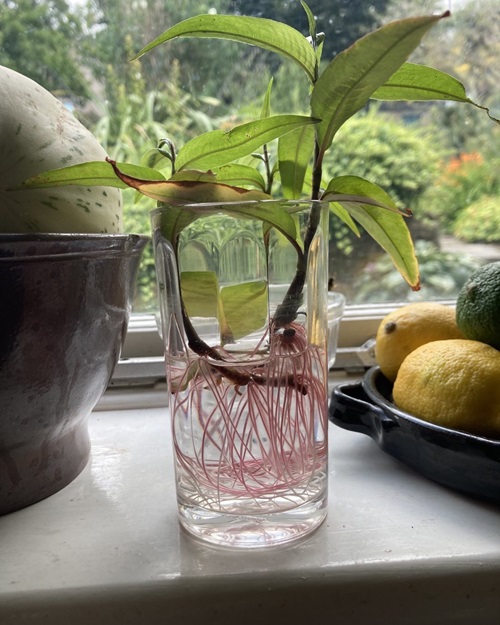Vietnamese Coriander is a must-have in meat dishes and adds a dash of flavor you just can’t miss! Here’s everything about growing it!
Vietnamese Coriander
Vietnamese coriander is a plant from Southeast Asia that grows well in warm and damp tropical or subtropical climates.
Even in my North American summer, it’s doing great. The humid weather has helped it thrive, turning a small cluster into a bushy plant under my tomatoes.
It has long stems that grow straight up and narrow, blade-shaped leaves. Most of the leaves are green, but some have maroon patterns near the base.
Vietnamese Coriander Flavor and Uses
Vietnamese coriander, also called Rau Ram, tastes like fresh cilantro but with a stronger kick of citrus and spice. The bold flavor works best in dishes with intense flavors.
It has a slight soapy smell and taste, but it’s still tasty.
Use it to add a punch to salads, and it’s also great in stir-fries, curries, spring rolls, soups, and other dishes.
Vietnamese coriander goes well with ingredients like tomato, coconut, ginger, chili peppers, yogurt, chicken, duck, and whitefish. It also has some health benefits—Rau Ram is a natural anti-inflammatory and can help with indigestion and stomach aches.
Propagating Vietnamese Coriander
Choose a healthy and established Vietnamese Coriander plant that you want to propagate. Use clean pruning shears or sharp scissors to cut a stem from the parent plant about 4-6 inches (10-15 cm) long. Cut just below a node. Remove any lower leaves, leaving a few leaves at the top.
Fill small pots or containers with a well-draining potting mix. Insert the cut end of the stem into the potting mix.
Place a plastic bag or wrap over the pots to create a mini-greenhouse effect. This helps retain humidity and encourages root development. Make sure the plastic doesn’t touch the leaves.
Place the pots in an area with indirect sunlight or dappled shade. Avoid direct sunlight during this phase.
Check the cuttings regularly to ensure the potting mix remains lightly moist. Mist the cuttings and the inside of the plastic covering if needed.
The cuttings should develop roots after a few weeks (typically 2-4 weeks). You can gently tug on them to check for resistance.
Once the cuttings have well-established roots, remove them from the pots and transplant them into larger containers or your garden.
Best Pot Size for Growing Vietnamese Coriander
For Vietnamese Coriander, you can use an 8-12 inches pot. It will be more than enough to give a plentiful harvest all year round!
Requirements for Growing Vietnamese Coriander

Sunlight
Vietnamese Coriander thrives in partial to full sunlight. Aim to provide the plant with a minimum of 6 hours of direct sunlight per day for optimal growth and flavor.
It may benefit from a bit of afternoon shade during extremely hot seasons to prevent leaf scorching.
Soil
This tropical plant grows best in rich, fertile soil that drains well. It likes the soil to stay moist, as it can wilt if the soil dries out.
Water
To help the plant grow well, make sure the soil stays wet. If planting in the ground, choose a low spot in the garden that holds moisture. These plants wilt if they don’t get enough water. For potted plants, water them every day. You can also add mulch, like straw, leaves, or wood chips, to keep the soil moist and stop weeds from growing.
Temperature
Vietnamese Coriander is a tropical plant and thrives in warm conditions. It does best in temperatures ranging from 70 to 90°F (21 to 32°C).
Be cautious of frost, as this plant is not frost-tolerant. If you live in a region with colder seasons, consider growing Vietnamese Coriander in pots that can be brought indoors during winter months.
Vietnamese Coriander Care
Fertilizer
Liquid plant fertilizer is great for this plant. During warm weather, fertilize it twice a month, and in cooler weather, do it once a month. If the plant is in a container, feed it more often to make up for nutrients washing out of the soil. Use a balanced fertilizer for the best results.
Pruning
Use clean garden shears to cut back stems that grow outside the area you want. Pruning helps the plant grow better, making it bushier and stronger. Regular trimming keeps the plant fresh and prevents it from becoming too woody.
Pests and Diseases
Vietnamese coriander doesn’t usually get pests or diseases. If the leaves turn yellow or start falling off, check for aphids or spider mites—these are the most common problems. You can spray the plant with water to keep these pests away.
Harvesting and Storing Vietnamese Coriander
Harvest Vietnamese coriander when the leaves are fully grown but still soft. To keep it growing and full, pinch off the tips of each shoot as you pick. The younger leaves taste the best.
After picking, keep Vietnamese coriander in the fridge and use it within a week. You can rinse and dry the leaves, then store them in plastic bags, or put a few stems in a container of water and cover them with a plastic bag.
Vietnamese Coriander Uses
Use this coriander instead of cilantro or mint in recipes. It’s not just for Asian dishes like spring rolls or stir-fries—you can also use it to make pesto or add it to a herb dip. With its refreshing, lemony flavor that’s milder than arugula, it’s a very versatile herb for cooking.













